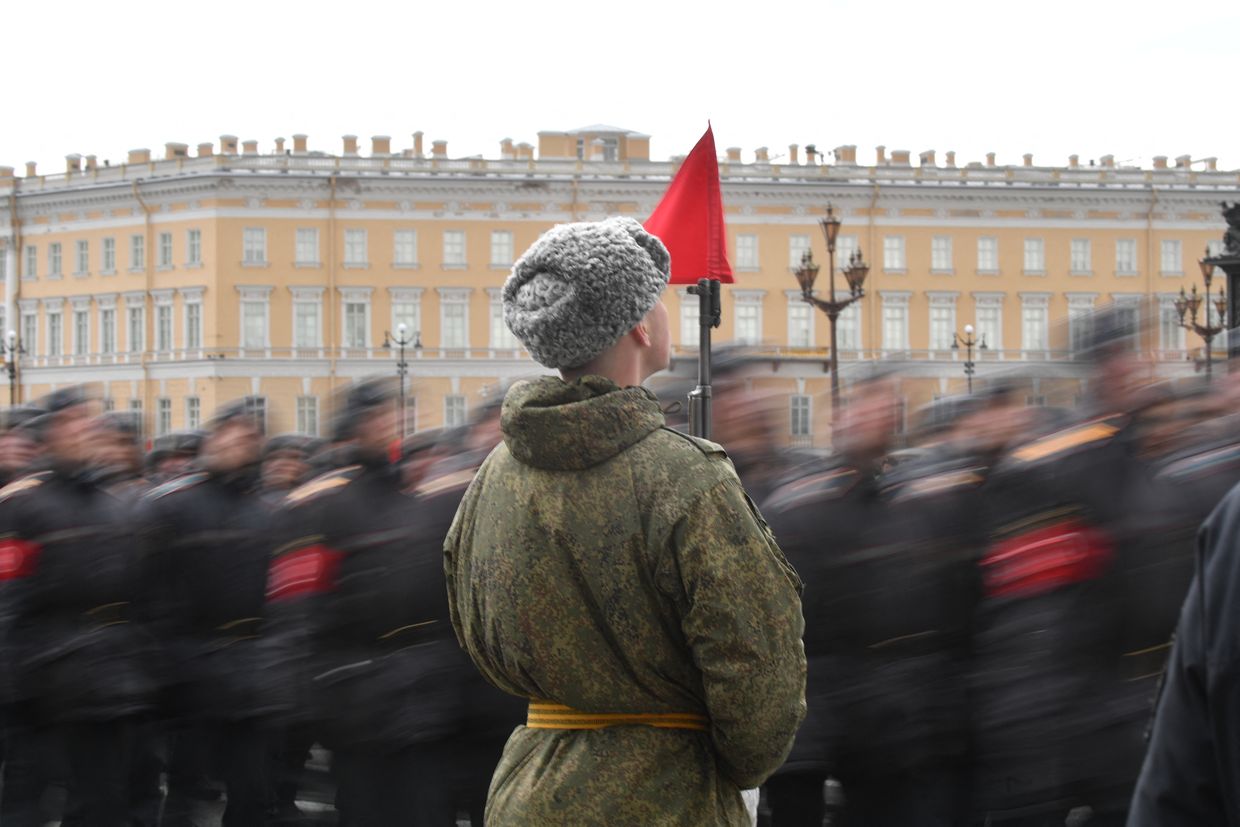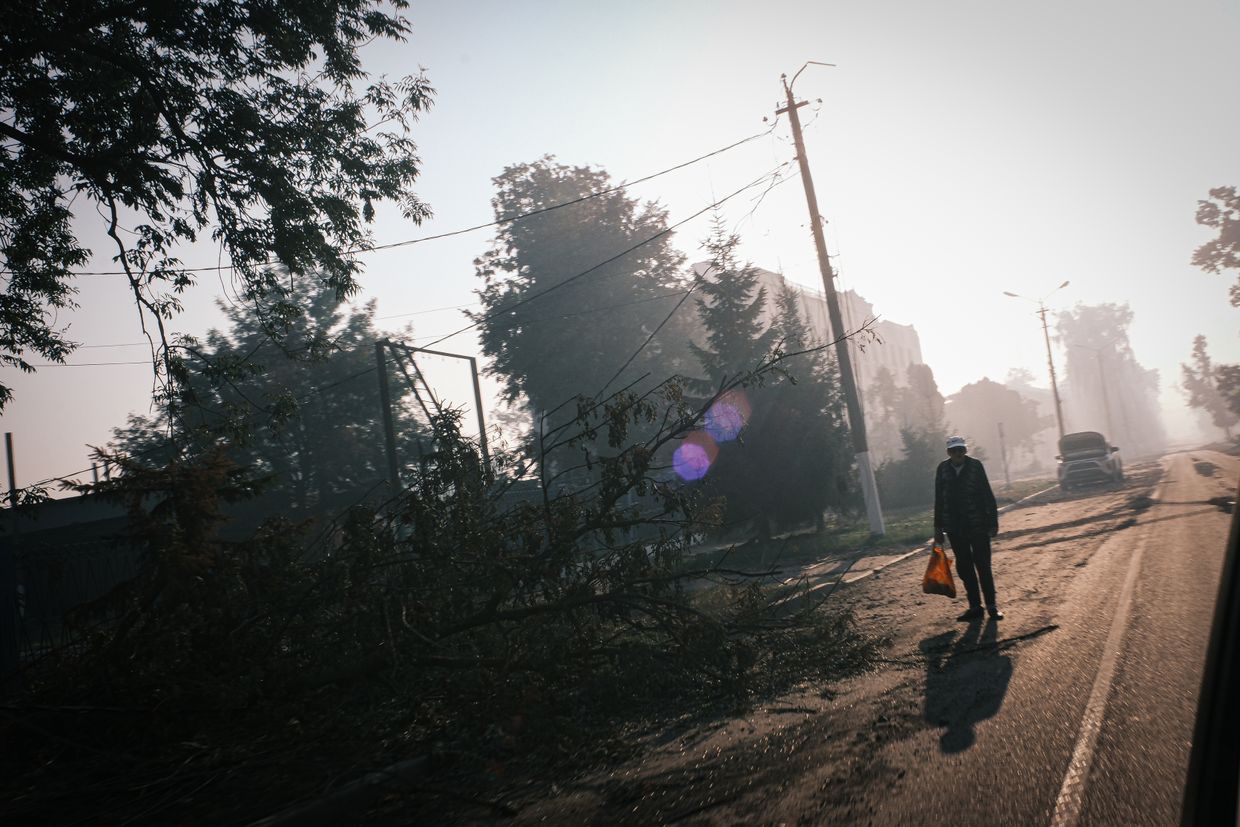
Russia launches counteroffensive in Kursk – can it push Ukraine off its own turf?
President Zelensky confirmed Russia’s Kursk Oblast counterattack, claiming things are going “according to our Ukrainian plan,” but doubt about the outcome looms.
A Ukrainian tank covered with an anti-drone net drives in Ukrainian-held Russian territory away from the border in Kursk Oblast, Russia, on Aug. 18, 2024. (Ed Ram/For The Washington Post via Getty Images)
More than a month after Ukraine launched an unprecedented incursion into Russian territory, Russian forces have begun counterattacking in Kursk Oblast, aiming to eventually drive Ukrainian troops out of the partially occupied border region.
President Volodymyr Zelensky confirmed reports about the Kursk counteroffensive at a press conference on Sept. 12, cryptically adding that "everything is going according to our Ukrainian plan."
He did not provide further details, but the developments unfolded as Zelensky continued pleading for Western allies to lift restrictions on the use of their long-range missiles supplied for strikes in Russian territory.
Ukraine's unexpected incursion into the border area patch of Russia's Kursk Oblast launched on Aug. 6 and marking the first invasion of Russian territory since World War II has dealt a blow to President Vladimir Putin’s image and lifted the spirits of Ukrainians and their allies two and a half years into Moscow’s full-scale invasion. The captured territory could also give Ukraine valuable leverage in future peace negotiations.
However, as Russian forces continue to make grinding gains in eastern Ukraine, some analysts have raised concerns about the effectiveness of using Ukraine’s limited resources to seize Russian territory. If Moscow's counteroffensive successfully reclaims the Ukrainian-held areas in Kursk Oblast, there is worry that these efforts may ultimately prove to be in vain.

Russia's Defense Ministry claimed on Sept. 12 that its forces had recaptured 10 settlements in Kursk Oblast since the counteroffensive began along the western flank of the Ukrainian-held area around Sept. 10. The settlements reportedly include Apanasovka, Byakhovo, Vishnevka, Viktorovka, Vnezapnoye, Gordeyevka, Krasnooktyabrskoye, Obukhovka, Snagost, and 10-y Oktyabr.
The extent of what territory Russia’s forces have reclaimed remains unclear, as Moscow’s claims have not been independently verified, according to Emil Kastehelmi, an OSINT analyst with the Finland-based Black Bird Group and military history expert.
"The Russians have gained local success, likely by pushing the Ukrainians back several kilometers and taking at least 2-4 villages," he said.
Pentagon spokesperson Major General Pat Ryder called Moscow's gains "marginal" at this stage but "something obviously that we're keeping an eye on."
Ukraine's military has not yet commented on Russia's counteroffensive in the region.
In his latest update on the situation on Sept. 6, Zelensky said Ukraine controlled over 1,300 square kilometers and approximately 100 settlements in Kursk Oblast. According to the Ukrainian crowd-sourced monitoring group DeepState, Ukrainian forces held around 875.3 square kilometers as of Sept. 12.
What is Russia trying to achieve?
Kastehelmi said that the Russian counterattack aims to "open a land route" from Glushkovo to Korenevo to mitigate the impact of Ukrainian strikes on bridges over the Seim River, which posed a logistical challenge for the area to the south.
"To continue supplying the area, the Russians were forced to deploy temporary bridges, which were also targeted by Ukrainian strikes. This problem is solved with the current counterattack," Kastehelmi said.

Additionally, the counteroffensive reduces Ukrainian-held territory in Kursk Oblast, potentially complicating further Ukrainian advances toward Lgov, "depending on how far the Russians can advance with their current attack," Kastehelmi added.
The Institute for the Study of War (ISW), in its latest assessment on Sept. 11, said that Russian forces might aim to temporarily split the Ukrainian salient in Kursk Oblast to establish better tactical positions before launching a more coordinated campaign to expel Ukrainian troops from Russian territory.

"Russian forces may be working to establish more tactically favorable positions during these initial counterattacks before beginning a wider counteroffensive operation against Ukrainian forces operating northeast of Korenevo and near Sudzha," reads the report.
Sudzha is the largest Ukrainian-held settlement in Kursk Oblast and home to a key processing point for Russian gas being exported to Europe through vast pipelines traversing Ukraine.
The town seems secure at the moment, lying around 25 kilometers southeast of Obukhovka, the closest village Russia claims to have recaptured during its counteroffensive.
A Ukrainian combat medic serving near Sudzha told the Kyiv Independent that "things are more or less stable" in the area, adding that his unit is "expecting an offensive from the Russian side."
Will Russia’s counterattack affect broader battlefield?
Kyiv has said that one of the main objectives of the Kursk incursion was to divert Russian forces from the eastern Ukrainian Donbas front, where Moscow is closing in on the strategic city of Pokrovsk and advancing in other sectors.
According to Zelensky, as of early September, Russia had pulled over 60,000 troops to face Ukraine's ongoing incursion in Kursk Oblast, while Commander-in-Chief Oleksandr Syrskyi estimated in late August that 30,000 troops had been diverted to the region.
While it remains unclear how many Russian troops are involved in the counteroffensive, elements from several brigades, including the 155th Marine Brigade, 51st and 56th Airborne Regiments, are reportedly participating.
Despite redeployments, Russia appears to have enough reserves to sustain offensives in both Kursk and Ukraine’s Donetsk Oblast, according to Kastehelmi.
Though signs of stabilization have been observed near Pokrovsk in the last two weeks, Russia has not ceased its main offensive operation in the area, with continued attacks probing for weaknesses, according to Dara Massicot, a senior fellow at the Carnegie Endowment for International Peace’s Russia and Eurasia Program.
Meanwhile, the situation is growing increasingly difficult near Vuhledar, a small mining town south of Pokrovsk critical for Ukrainian defense in the southern part of Donetsk Oblast.
"The counterattack in Kursk is unlikely to change the general situation in Ukraine's favor elsewhere, but there is a possibility that some areas could face less pressure for a certain time. However, the effect is likely rather local," Kastehelmi said.

Will Russia push Ukrainian forces out of Kursk Oblast?
Several days into the counteroffensive, it's too early to assess whether Ukraine will be able to hold the captured land in Kursk Oblast and what this development could mean for the war, experts say.
Ukrainian military expert Serhii Zghurets wrote in his guest article for Espreso television channel’s website that the Russian counteroffensive in Kursk Oblast was anticipated. According to Zghurets, the attack could allow Ukrainian forces to achieve some of the initial goals of the Kursk operation.
"Russia has finally taken the step that our military planners anticipated when preparing for the offensive with the invasion of Kursk Oblast. Specifically, forcing the enemy to redeploy forces to this new front from other areas, including Pokrovsk, creating a buffer zone in Sumy Oblast, and ensuring maximum destruction or capture of the enemy's personnel and equipment," Zghurets wrote.

The ISW wrote in its Sept. 11 report that Moscow might consider transferring additional, more capable units from Ukraine to respond to the Ukrainian operation in Kursk Oblast.
"It remains unclear if the Russian authorities responding to the Kursk incursion assess that the current Russian force grouping in Kursk Oblast — largely comprised of conscripts, irregular Russian forces, and smaller elements of regular and more elite Russian units — can successfully push Ukrainian forces from the area."
Massicot echoed this suggestion, noting that "the Russians redeployed forces from many places along the front line to support Kursk, but the force there remains highly variable in terms of force quality."
Meanwhile, Ukrainian forces have begun new attacks in Kursk Oblast and appear to have contained the initial push of the Russian counteroffensive, "but the situation can still change," according to Kastehelmi.
Ukraine will likely try to solidify its positions in Kursk, building fortifications on the Russian side of the border if it plans to hold the area long-term, said Kastehelmi.
"The Ukrainians might try to advance in some areas, but the advances will likely be gradual instead of rapid," Kastehelmi added.
Note from the author:
Hi there, this is Dinara Khalilova, the author of this article. We need your support to continue reporting on key developments on the battlefield and the challenges Ukraine faces in its fight against Russian aggression. Please consider becoming a member of the Kyiv Independent community.













